It is remarkable with ex-battery hen's how, with proper food, room to spread their wings and a little TLC, quickly your hens will be back to health. Even the most wretched and naked looking hen, will re-feather and be charging around your garden again in no time.
 |
| Maggie's Six Hen House |
Cal-Boost Poultry Calcium Liquid
When you get your ex-batt hen it will be retiring from a job that required it to lay as many eggs as possible, every day, day after day, all year long. Understandably, the poor girls are tired. But this intensive egg laying can also lead to a calcium deficiency in the bird. As I'm sure your aware, egg shells are made from calcium and a calcium deficiency in the bird can lead to weak shelled and deformed eggs. It is also to be remembered that a hens physiology means it will use calcium from its skeleton to make shells for its eggs, thereby weakening its bones.
Cal-Boost Poultry Calcium Liquid is a concentrated calcium and mineral supplement (with additional vitamin D3) which when added to drinking water helps improve egg shell quality and thickness. The tonic is so concentrated it only requires two drops per litre of water. Ideal for tired ex-bat's when you administer this to the birds you will not see results immediately. The hens need to re-build the levels of calcium in their bones before they move on to laying good shelled eggs.
Smallholder Layers Crumble
The diet of a battery hen isn't spectacular. Most will have been fed a dry mash or similar during their working life. As such they often look under-fed and in a sorry state when you pick them up and take them to their new home.
Smallholder Free Range Layers Crumble is the perfect bridge feed for giving to your ex-batt's as you move them onto a more standard feed like Layers Pellets. As a crumble the feed is more similar to what ex-bat's are used to, however it also has the high level of protein (16%) and other essential nutrients and oils to get your new hens back up to scratch. It is remarkable when given a high quality feed, how quickly a hen will re-feather and look brighter and alert.
 |
| Hobby Hen Houses |
Part of being an ex-battery hen is the lack of space, being all cooped up (pardon the pun) within their coops. As part of their retirement, make sure that you get a house that provides the number of hens you rescue, adequate space to live happily.
Flyte so Fancy Hen Houses and runs are built within DEFRA guidelines to create happy hens living in healthy houses. With more that recommended perch space inside the coop and plenty of room in the runs too, there is enough room to stretch your feathers. The Maggie's Six Hen House and Hobby Hen House are ideal starter homes, providing everything a poultry keeper needs to easily keep the coop clean and the birds happy.
If you have any questions about keeping ex-battery hens why not leave a comment below, or call 01300 345229 to talk to a member of the Flyte so Fancy team.
Thanks for Reading
James


